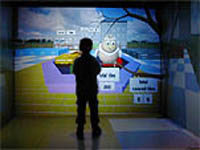Dr. Maria Roussou
July 18th, 2006
Categories: Applications, Education, VR

About
EVL graduate Maria Roussou completed requirements for a Doctorate of Philosophy from the University College of London, Department of Computer Science, July 18, 2006. Under the advisement of Dr. Mel Slater, Maria’s research interests in interactive education culminated in the thesis entitled, “Interactivity and Learning: Examining primary school children’s activity within virtual environments”. This research is a direct extension of Maria’s earlier work with interactive virtual reality learning environments explored while a MFA and MS graduate student at EVL / UIC.
Abstract
This research investigates user interaction in virtual reality learning environments, focusing on the role and the effect of interactivity on learning and change in conceptual understanding. The goal had been to examine if children learn better by interactive in an immersive virtual environment (VE), i.e. exploring, reacting to, and acting upon events. The two essential properties of a virtual reality (VR) experience, especially in entertainment and informal learning applications, are immersion and interactivity - each of which is advertised widely to attract and motivate participants. In particular, it is commonly considered that a learning environment is more effective if it is interactive. However, little systematic research has been available to substantiate this assumption and no clear evidence has existed that interactive VE applications can bring “added value” to learning, especially in children.
In this research, empirical studies were carried out with 60 primary school students (ages 8 - 12), in a number of different studies. An exploratory study was carried out to test the methodology and prepare for the main study. The main study, a large scale experiment, was conducted with a VE designed to simulate a ‘virtual playground’, which focused on a presentation of problems in mathematical fractions. Three conditions - an interactive VR, a passive (or guided) VR, and a non-VR condition - each with different levels of activity and interactivity, were designed to evaluate how children accomplish the various conceptual tasks. Pre-tests, post-tests, interviews, video and computer activity logs were collected for each participant, and analyzed both quantitatively and qualitatively. The results indicate that activity based on the cues or feedback provided by the VE led participants to complete the tasks successfully (i.e. problem solving) compared to the non-VE condition. However, it was the passive rather than the interactive condition that provided evidence of sustained conceptual change.